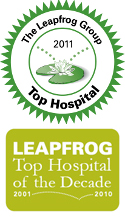A Member of the University of Maryland Medical System | In Partnership with the University of Maryland School of Medicine
Home > Medical Reference > Encyclopedia (English)
Toggle: English / SpanishManiobra de Heimlich - All Information
Nombres alternativos
Maniobra de Heimlich en caso de asfixia; Compresiones abdominales
Definición:
Es una técnica de emergencia para prevenir la asfixia cuando se bloquean las vías respiratorias de una persona con un pedazo de alimento u otro objeto.
Ver también:
Consideraciones generales:
Se puede utilizar de manera segura tanto en niños como en adultos, pero la mayoría de los expertos no la recomiendan para bebés menores de un año. Uno puede llevar a cabo esta maniobra en uno mismo.
Primeros auxilios:
- Para una persona consciente que esté sentada o parada, ubíquese detrás de ella y coloque los brazos alrededor de su cintura.
- Coloque el puño, con el pulgar hacia adentro, justo por encima del ombligo de la persona, y agarre el puño firmemente con la otra mano.
- Hale el puño con fuerza y abruptamente hacia arriba y hacia adentro para aumentar la presión en la vía respiratoria por detrás del objeto causante de la obstrucción y forzarlo a salir de la tráquea.
- Si la persona está consciente y acostada boca arriba, ubíquese por encima de ella con una pierna a cado lado. Empuje el puño agarrado hacia arriba y hacia adentro en una maniobra similar a la de arriba.
Es posible que se deba repetir el procedimiento varias veces antes de lograr desalojar el objeto. Si los repetidos intentos no logran abrir la vía respiratoria, puede ser necesario practicar una incisión de emergencia en la tráquea (traqueotomía o cricotirotomía).
- Reviewed last on: 7/16/2011
- Jacob L. Heller, MD, MHA, Emergency Medicine, Virginia Mason Medical Center, Seattle, Washington, Clinic. Also reviewed by David Zieve, MD, MHA, Medical Director, A.D.A.M., Inc.
Referencias
Manno M. Pediatric respiratory emergencies. In: Marx JA, Hockberger RS, Walls RM, et al, eds. Rosen’s Emergency Medicine: Concepts and Clinical Practice. 7th ed. Philadelphia, Pa: Mosby Elsevier; 2009:chap 166.
Braithwaite S, Perina D. Dyspnea. In: Marx JA, Hockberger RS, Walls RM, et al, eds. Rosen’s Emergency Medicine: Concepts and Clinical Practice. 7th ed. Philadelphia, Pa: Mosby Elsevier; 2009:chap 17.
 A.D.A.M., Inc. is accredited by URAC, also known as the American Accreditation HealthCare Commission (www.urac.org). URAC's accreditation program is an independent audit to verify that A.D.A.M. follows rigorous standards of quality and accountability. A.D.A.M. is among the first to achieve this important distinction for online health information and services. Learn more about A.D.A.M.'s editorial policy, editorial process and privacy policy. A.D.A.M. is also a founding member of Hi-Ethics and subscribes to the principles of the Health on the Net Foundation (www.hon.ch).
A.D.A.M., Inc. is accredited by URAC, also known as the American Accreditation HealthCare Commission (www.urac.org). URAC's accreditation program is an independent audit to verify that A.D.A.M. follows rigorous standards of quality and accountability. A.D.A.M. is among the first to achieve this important distinction for online health information and services. Learn more about A.D.A.M.'s editorial policy, editorial process and privacy policy. A.D.A.M. is also a founding member of Hi-Ethics and subscribes to the principles of the Health on the Net Foundation (www.hon.ch).
© 2011 University of Maryland Medical Center (UMMC). All rights reserved.
UMMC is a member of the University of Maryland Medical System,
22 S. Greene Street, Baltimore, MD 21201. TDD: 1-800-735-2258 or 1.866.408.6885













